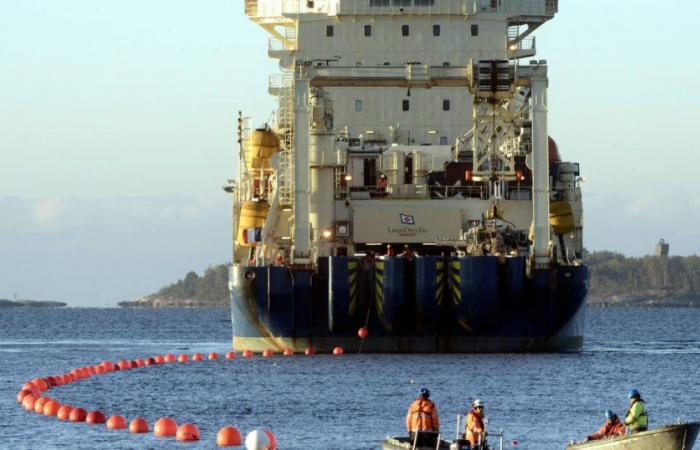After the damaged cable between Finland and Germany, it is the turn of the one connecting Sweden and Lithuania to be broken. German Defense Minister Boris Pistorius spoke this Tuesday, November 19 “sabotage” certainly at the origin of the damage observed in forty-eight hours on these two telecommunications cables. Since the start of the war in Ukraine, incidents of this type have increased.
According to experts and politicians, these actions, targeting in particular energy and communication equipment, are part of the context of “hybrid warfare” between Russia and Western countries. Another type of conflict taking place in this vast area bordered by several NATO members, where Moscow also has entry points. Liberation takes stock of the different actions illustrating this latent conflict.
Gas pipelines and cables targeted
The most spectacular of these incidents occurred in the Baltic Sea, with the sabotage in September 2022 of the Russian Nord Stream gas pipelines, which has not yet been clarified. Four huge gas leaks preceded by underwater explosions occurred on September 26, 2022 on Nord Stream 1 and 2, pipelines which transported most of Russian gas to Europe. In August, the Wall Street Journal had implicated the former Ukrainian chief of staff, suspected of being involved in the sabotage of pipelines, while German media revealed the issuance by German justice of a European arrest warrant for against the Ukrainian. An accusation qualified as “absolute nonsense” through Kyiv.
The October 2023 incident concerning the Balticconnector gas pipeline, a structure linking Finland and Estonia, also remains an enigma: the connection was interrupted on October 8, 2023 after the detection of a leak which, according to the Finnish authorities, had was caused by external intervention, raising fears of possible sabotage. The same month, an underwater telecommunications cable between Sweden and Estonia was damaged by “an external force” or a «manipulation», according to Stockholm.
GPS jamming that increases the risk of air accidents
Since Russia launched its invasion of Ukraine, GPS signal disruptions have intensified in this area. In April, Estonia, Latvia and Lithuania warned that Russia's widespread GPS jamming was increasing the risk of air accidents. At the same time, the Finnish airline Finnair suspended its flights to Tartu in Estonia for a month because of GPS interference, described by the Estonian Minister of Foreign Affairs “Russian hybrid attack”.
To respond to this threat, the British army announced in August the construction of an installation presented as one of the largest in Europe, intended to prepare its equipment for the risk of jamming the GPS signal.
Russian spy ships
Oceanographic ships, trawlers, cargo ships or even yachts: Russia uses all kinds of boats to collect valuable information in the Baltic Sea and the North Sea. In February 2023, Belgium announced that it had opened an investigation into the activities of a Russian “spy ship” spotted in November in areas of the North Sea where there are wind farms, underwater gas pipelines and cables. communication. In April 2023, Russia was accused by the main Nordic television stations of carrying out a espionage program in the waters of Northern Europe, using several dozen military and civilian vessels to scout for possible sabotage actions. . The Kremlin immediately swept aside “errors” and accusations “unfounded”.
On August 31, the death of the beluga Hvaldimir not far from Risavika in southwest Norway put an end to many fantasies. Observed for the first time in 2019 off the coast of Norway, the cetacean aroused the interest of Norwegian intelligence, who began to investigate its origin. Enclosures were finally spotted near the Russian city of Murmansk, in which dolphins, belugas and seals were kept in captivity, for unknown reasons. Norwegian authorities concluded that Hvaldimir was a spy animal trained by Russia. The Kremlin has never confirmed.
Buoys moved to modify borders
In May, the Estonian coast guard discovered that their Russian counterparts had removed buoys placed on the Narva River, which separates the two countries, overnight. Jens Stoltenberg, then Secretary General of NATO, affirmed his solidarity with Estonia, while the head of diplomacy of the European Union, Josep Borrell, described“unacceptable” this Russian operation to redistrict borders in troubled waters. The concern of Western leaders does not come from nowhere: in the spring, Russia issued a draft decree considering expanding the country's territorial waters by changing the borders in the Baltic Sea with Finland and Lithuania. Enough to put the Baltic Sea coast guard on alert.
Fly over European countries using drones
In Germany, the authorities took little notice of the flight over the town of Brunsbüttel by a Russian drone. In August, not far from the shores of the North Sea, several drone flights were observed for several days in a row above an industrial zone of the city. The drone was certainly not “not there to observe the beautiful local landscape, but because there is a chemical park and a nuclear waste storage facility nearby,” German Foreign Minister Annalena Baerbock then pointed out. Enough to motivate the opening of an investigation to “espionage with the aim of sabotage” by the local prosecutor's office.






